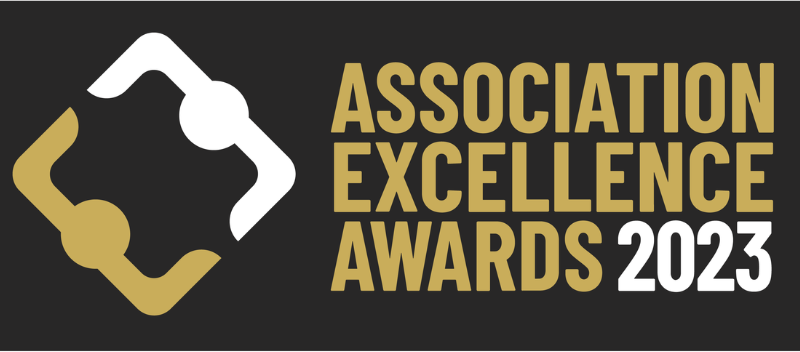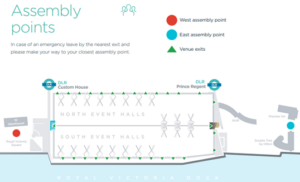

The information below provides an extensive overview of health and safety at the event. Although some exhibitors plan to set up a simple stand, we still require you to read through the information below before completing the Health & Safety Declaration Form, Exhibitor Risk Assessment Form and CDM Form. These forms are found at the bottom of this page and should completed and submitted online.
We have set out our responsibilities under the prevailing legislation and under the auspices of the Health and Safety at Work (etc.) Act 1974, together with subsequent Regulations, Amendments and Approved Codes of Practice. As a business and an exhibitor, you are also required to ensure that your attendance at the event is conducted in a way that exposes you and those around you to the minimal possible risk.
There are two stations adjacent to the venue – Custom House and Prince Regent, both of them are step-free. Click here to see TfL step-free station map to plan your journey.
ExCeL is a large venue and the central boulevard is 600m long. All public entrances allow for access by wheelchair via low gradient ramps and an automatic door. Once inside the venue, all floors are level, offering unobstructed access. Please visit https://www.excel.london/visitor/venue-guide/accessibility for more information.
Drinking of alcohol and use of drugs on site during the build-up and breakdown phase is forbidden. Any person found to be under the influence of alcohol or drugs would be asked to leave the site immediately.
Animals are not allowed on site unless they are part of the event. Guide and hearing dogs are permitted on request.
Balloons must be secured by suitable means; a charge may be made for retrieval if any escape to the roof or for any damage to air-handling units.
In April 2015, The Construction Design Management legislation came into force in the UK to further regulate the industry and ensure that safety was the highest priority.
It is now the responsibility of organisers, as principle contractors, to do all that is reasonably practicable to prevent personal injury and damage to property, and to protect everyone from foreseeable work hazards at all locations.
Co-operation and participation of all employees, trainees and sub-contractors is essential to obtaining high standards of safety practices. Therefore, no exhibitor or contractor will gain entry to the halls during construction or deconstruction, without a signed copy of the Site Induction Form which can be found at the bottom of this page.
If you have any further questions relating to Construction Design Management and how it affects your participation in this event, please contact Cristina Gaitens.
If you are unaware of the CDM law, please note the important information below as there are some actions for you to complete as an exhibitor.
What is the law? The Construction (Design & Management) Regulations 2015.
What does this mean? It means that legally, exhibition and other event sites are now under the same set of laws and controls as large-scale building and construction sites.
What is the practical effect? Like construction sites, whilst building or dismantling is occurring, we are legally required to implement safe working practices and other ‘control measures’ to limit risk – as are you.
What does this mean for you as an exhibitor, contractor or visitor to the site? It means that to gain access to the site during what we know as build-up or break down you will need to:
For space only exhibitors – The contractors you hired to build your stand MUST wear one during build and breakdown in the loading bay areas.
These are designed to avoid puncture or crushing injuries, such as a nail penetrating the foot or heavy item landing on it. Technically, this requires what you might think of as ‘work boots’ and are compulsory to wear during build and breakdown. For clarity Converse, open-toed shoes, sandals or any other soft-soled footwear are not sufficient and will mean our team reluctantly have to turn those wearing them away. Thick, leather-soled shoes may be acceptable and usually are Timberland boots, but on the basis that much of the leather/ sole remains and it is thick enough for a nail to bend rather than penetrate. Again, purchasing a good pair of sturdy boots is a good investment in comfort across all the trade shows you exhibit at.
Who controls all this? One significant change in the law is that inspections are now carried out by the government’s Health & Safety Executive who have the power to issue very substantial on-the-spot fines, so please ensure your safety, those of others and avoid risk by co-operating with what is a legal requirement on all of us.
Thank you for your cooperation. Our teams are available to assist, and we ask your help in making the process as easy and hassle-free as possible.
Children under 16 are strictly forbidden to be in the halls during the build-up and breakdown. There are no exceptions to this rule.
Cleaning of stands will be carried out overnight. General overnight cleaning will include sweeping, vacuuming, mopping and emptying of bins.
The venue will dispose of general waste and where possible will always recycle, however if you need to dispose of a large quantity of rubbish following the event, please contact cristina.gaitens@thepaymentsassociation.org
Please note that double-storey stands or stands higher than 3m are not allowed (unless you have been contacted by the organisers to say otherwise)
Licensees/Organisers/Contractors/Exhibitors/their staff and agents must keep ALL common areas clear whilst building or dismantling stands, exhibits etc. All exhibits must be kept within the confines of the stand space and demonstrations must not cause undue congestion and/or obstruction of common areas.
Use of gases will only be permitted where essential and by exception and these must be registered as a special risk. LPG is not allowed inside the venue. A certificate of installation by a GASSAFE registered fitter is required for LPG installations. Only one cylinder can be kept on the stand at any one time. Cylinders which have never contained gas (as opposed to cylinders which have been emptied) may be used for display purposes.
Exhibitors intending to use televisions or any other potentially loud appliances for stand demonstrations or who wish to hold live demonstrations must contact the organiser for approval at least one month prior to the show to gain written permission.
All necessary precautions should be taken to protect the fabric of the building from damage during the construction and dismantling of stands and features. Any damage to the venue, over and above normal wear and tear to the building will be charged accordingly. This includes the removal of carpet tape, fixings and nails and cleaning/repair of any other damage to the floor however caused.
Entrances, exits and gangways must be a minimum of 2m wide. Exits with doors opening directly onto a gangway must be recessed into the stand.
Exhibitors are reminded that they must comply with the stringent regulations governing materials used on site during an exhibition. Exhibitors must ensure that all exhibits are within their stand boundaries and that they do not block aisles, fire exits or fire equipment.
Evacuation: If an evacuation is necessary, you will hear the following announcement broadcast over the public address system “Attention please, attention please. Here is an important announcement. It is necessary to ask everyone to leave the building. Please make your way calmly to the nearest exit. Do not return to your vehicles. Everyone will be re-admitted as soon as possible.” Please leave by the nearest fire exit or as instructed by members of the security staff. Please familiarise yourself with the nearest fire exits to your conference room or exhibition stand.
Fire: Fire assembly points are as follows:

On discovering a fire: Break the glass on the nearest manual call point (coloured red), which are located adjacent to all exits, or contact the Security Suite by dialling 4444 on an internal telephone or 020 7069 4444 immediately.
Please remember:
Medical emergencies: The Medical First Aid room is located on level 0 between N4 and S4 boulevard shutters.
down the stairs.
The ExCeL’s Emergency Procedures video can be viewed here. We strongly encourage all exhibitors to watch the video prior to coming on site.
As an exhibitor you have a legal duty of care for the safety of anyone who may be affected by your activities. You are ultimately responsible for all aspects of safety on your stand during the build-up, the open period of the show and during the break down. Where you contract out the building and finishing of your stand you are still vicariously responsible for the activities of your contractors. You can discharge your duties by ensuring that you do the following:
Qualified First Aiders are on site during all events. Should you have a medical emergency please notify your Event Manager or a member of ExCeL staff who will arrange for someone to come to you. The First Aider will arrange an ambulance should this become necessary.
There is a significant risk of slips, trips, falls and sharp objects left on the ground. All those working in the halls in build-up and breakdown are strongly advised to wear appropriate safety footwear.
No artificial plants and flowers may be used for dressing stands at ExCeL. Only real and silk-type flowers and leaves can be used. The silk-type must be clearly marked as conforming to BS 54387.
Exhibitors have a duty to ensure proper food hygiene to guard against contamination and food poisoning. It is compulsory to use our recommended caterer for this reason.
Fumes are NOT permitted in the exhibition.
Hanging wires are not to be left hanging below head height and must be marked with tape.
Any exhibit, process or feature that is likely to generate and/or emit gases, vapours, liquids, fumes or dusts into the venue must not be used without written approval from the venue and must not present any hazard to health.
Hazardous substances are not to be brought into the halls unless essential. The use of hazardous substances must be subject to a COSHH assessment. Exhibitors must declare the use or display of hazardous substances as a special risk.
Any company proposing to use lasers must inform the organiser immediately, together with details of laser equipment, a drawing of the stand and the location of the beam. The Local Authority Regulations, which apply to laser use within exhibition venues, must be strictly adhered to (further details available on request).
Exhibitors wishing to play recorded material or perform music live in public must obtain a licence from the Phonographic Performance Limited (PPL) and the Performing Rights Society (PRS). Exhibitors are solely responsible for obtaining any licence required to play music on their stand. Please firstly agree permission with Cristina Gaitens (cristina.gaitens@thepaymentsassociation.org) at least 2 months prior to the event.
All personal and company property is left at the owner’s risk either in the venue or the car park. ExCeL is not responsibility for damage or loss of any properties belonging to exhibitors or their agents or contractors.
Exhibitors should arrange their own insurance against all risks. The strongest possible precautions against theft should be taken at all times.
The venue will provide general security within the exhibition hall. However, responsibility for the security of individual stands and their exhibits lies with the exhibitor.
For reasons of security, all exhibitors are advised to remove all portable and valuable items whenever their stands are unattended, including during build-up and breakdown. It is recommended that exhibitors do not leave their stands unattended at any time when the hall is open, whether during build-up, exhibition viewing or breakdown periods. In the event of loss or damage, the organisers should be informed immediately.
Plan ahead and pre-order a waste disposal service for building materials and general rubbish that you may be unable to take away from site in your vehicle. Please remember that any waste left on site will incur a surcharge for removal. Go to www.excel.london/webshop or contact exhibitororders@excel.london to book waste disposal services. Please remember to confirm your order by 19 February to benefit from the advanced order rate.
Recycling and reducing waste is everyone’s responsibility. There could be some items that you don’t want to take with you, but someone might find useful. That could be pens or notepads or even, things like cushions or fabrics. Why not donate them to a local charity? ExCeL can arrange for a local charity CFE, ahead of the event to arrange collection, if the item is useful to them. For more information on what can be donated, please visit www.c-f-e.org.uk/.
Waste generated during the open days: Exhibitors should put full bin bags in the aisle at the end of each open day so that it can be collected by the cleaners. Please note that any items left in the aisles during open days will be considered litter and disposed of.
A person is working ‘at height’ if there is a possibility of their being injured from falling, even if they are working at or below ground level. All rigging from the roof is to be carried out by the official rigging contractor.
Working at height is to be in accordance with LOLER and the Working at Heights Regulations. As such, all working at heights is subject to risk assessment. It is the exhibitor’s / contractor’s responsibility to ensure the following:
Ladders: All reasonable steps should be taken to eliminate or minimise the risks associated with work at height through efficient work planning and selection and use of safe working platforms or other suitable equipment, including ladders and stepladders.
Ladders can be used as working platforms when it is not reasonably practicable to use alternative means and a risk assessment identifies the activity to be undertaken is low risk.
Ladders must be used in accordance with manufacturer’s instructions at all times. Additionally, the following guidelines must be followed:
Now that you have read all the above important health and safety information, please complete and submit the following online forms:
We value your privacy and trust. That’s why we will never share your details with any third parties without your consent, and we will never ever sell them. If you receive an email offering our data for sale (sometimes pretending to be from us), it will be a scam. Please do not respond but email it to dataprotection@thepaymentsassociation.org so we can take action where possible.
19th – 20th March 2024
ExCeL, London